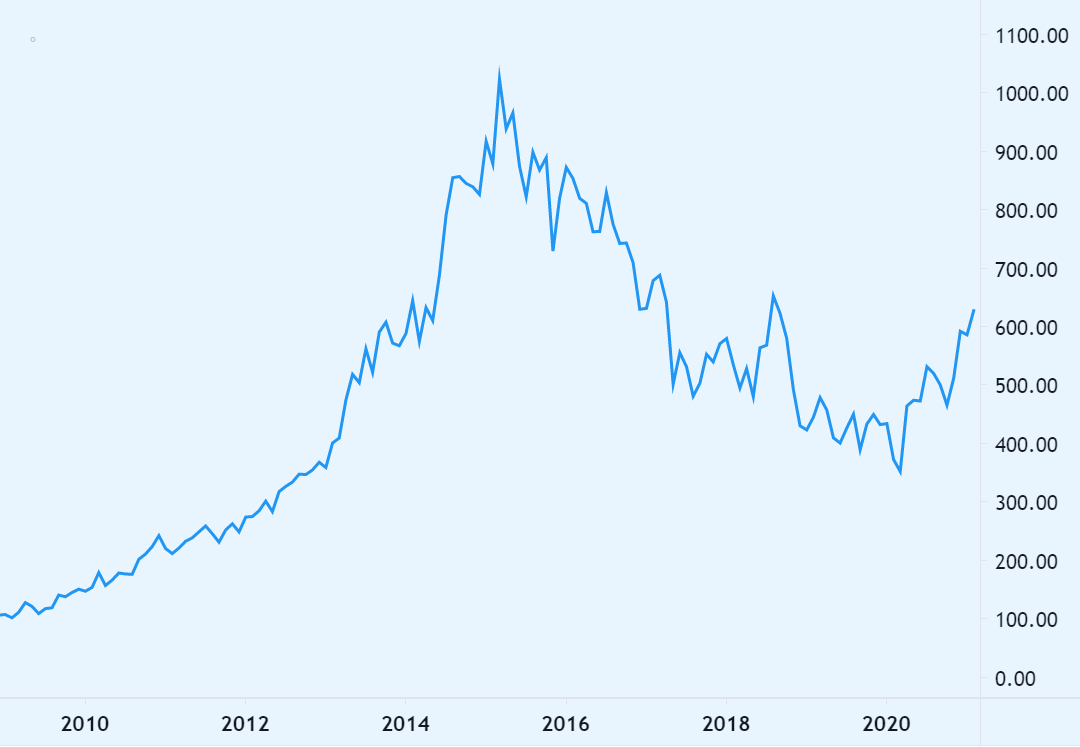Today is Valentine’s Day and if there is one stock market lesson to be learnt on this day – it’s a simple one.
Love the market. But do not fall in love with your stocks.
Falling in love with your stocks – is one of the most common mistakes that investors do. This behavior can prove to be costly, as stocks can undergo price correction as well as time correction for a prolonged period of time.
In fact, the period when valuations are stretched to the extremes on the upside as well as downside – can go on for several years.
Let’s take the example of Sun Pharma.

The stock started its ‘uptrend’ in 2009. From around ₹ 100 per share, the price rose to an all-time high of ₹ 1200 exactly 6 years later in 2015.
Now, most people do not buy a stock at the start of an uptrend.
Participation in a stock increases as the price rises.
So, assuming an individual bought it at around ₹ 250 per share and managed to hold the stock throughout. At the peak in April 2015, he would’ve earned annual returns of 48% (CAGR).
Those are outstanding returns.
However, by this time, a long term investor would’ve already fallen in love with ‘Sun Pharma’ and decided to hold the stock for life.
Little would he know that the company would enter a painful phase of 5 years – during which the stock would undergo both price and time correction.
At the time of writing this article (Feb 2021), we are in a strong bull market. Nifty is hitting all-time highs everyday. Yet, ‘Sun Pharma’ is trading at a price of ₹ 600 per share.
That’s 50% lower than its highest price in April 2015.
What are the returns the ‘long term investor’ would make if he is still holding the stock?
From ₹ 250 in 2011 to ₹ 600 in 2021. The 10 year returns would be just 9.15% – slightly higher than a fixed deposit in a bank, but lower than returns from most mutual funds.
Those who entered at higher levels between 2014 – 2017, would be in losses. The stock could take a few more years to get back to its 2015 highs.
Sun Pharma is just one example. Almost every company has undergone large periods of time / price correction.
- Reliance did not give any returns for 10 years between 2008 and 2017.
- Until recently, Larsen & Toubro, India’s biggest infrastructure company did not give any returns for more than 10 years.
- Hindustan Unilever (HUL) did not give any returns between 1999 and 2009. The stock price averaged around 225 rupees per share.
These are some of the biggest companies in India. There are several such examples of companies giving zero returns to shareholders over long periods of time.
Exit strategy is important
Buying a stock is easy. Selling it at the right time is difficult. Hence, having an exit strategy is a very important part of stock market investing.
Gains accumulated over the course of several years or decades, can be lost in a few days or weeks.
If you have made big gains in a stock, it’s very important to protect the returns.
Protecting returns does not mean selling a stock which has quickly gone up by 50%. A stock which is up by 50-100%, can rise another 200-300% in quick time.
The top of a stock can never be predicted. So do not make the mistake of selling too early to book small gains. Let the stock rise.
It’s best to invest time in learning technical analysis. Charts can give clear indications when a stock returns from an ‘uptrend’ to ‘downtrend’. When there are clear indications that a particular stock has entered into a downtrend, it’s best to exit it – even if it has already fallen 15-20% from the top.
This is a short article on a much larger and deeper subject. I hope you found the article useful.
Any questions, kindly post in the comments section below.

Leave a Comment